【全程方略 语法攻略】2014年中考语法专项复习课件:句子种类(含2013年中考真题,49张PPT)
文档属性
| 名称 | 【全程方略 语法攻略】2014年中考语法专项复习课件:句子种类(含2013年中考真题,49张PPT) |
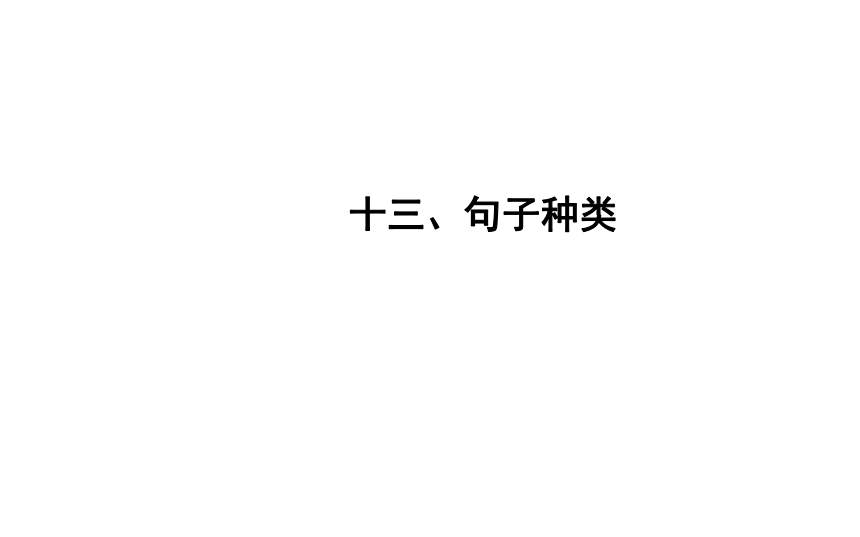
|
|
| 格式 | zip | ||
| 文件大小 | 3.0MB | ||
| 资源类型 | 教案 | ||
| 版本资源 | 通用版 | ||
| 科目 | 英语 | ||
| 更新时间 | 2014-01-18 07:55:19 | ||
图片预览

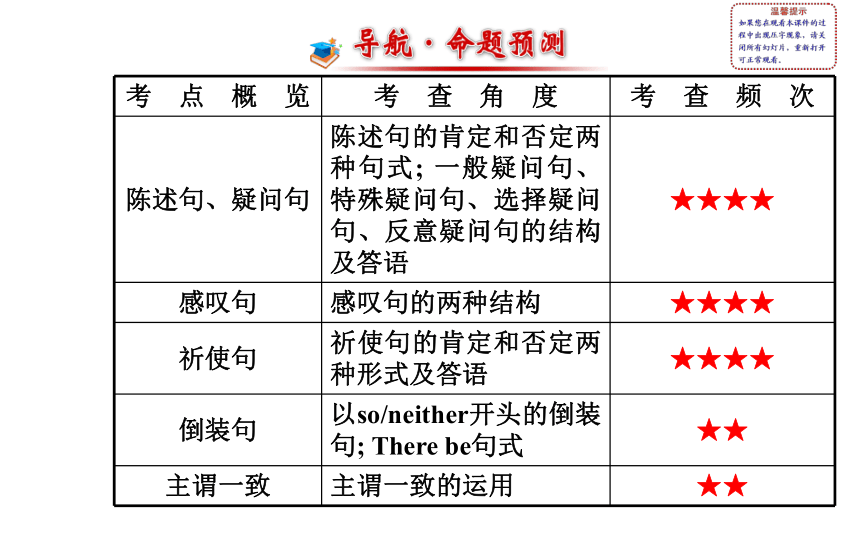
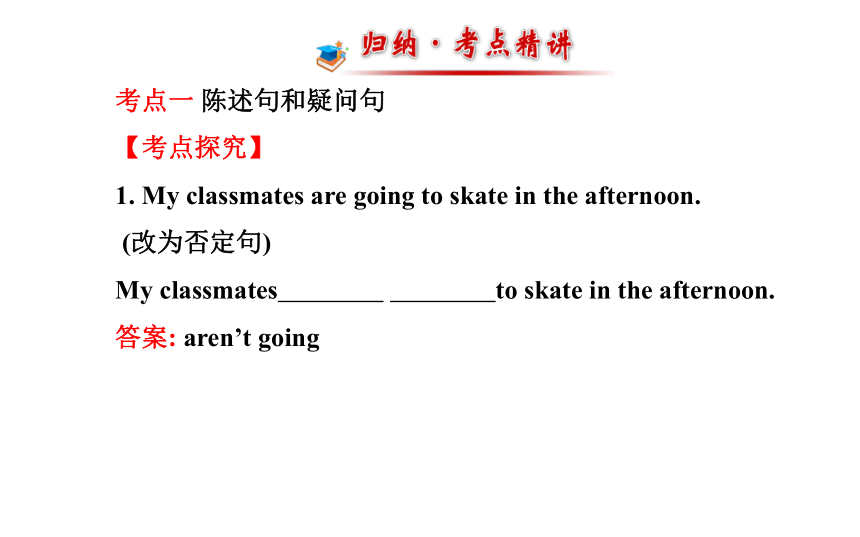
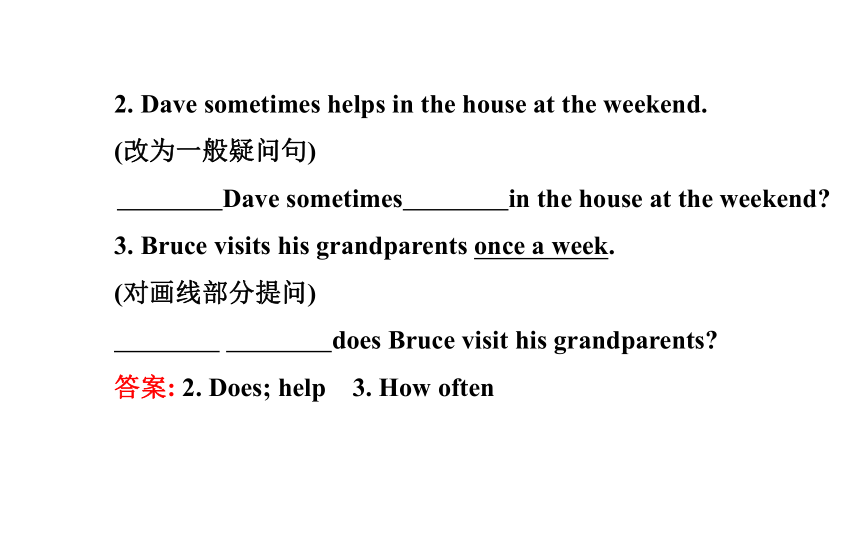
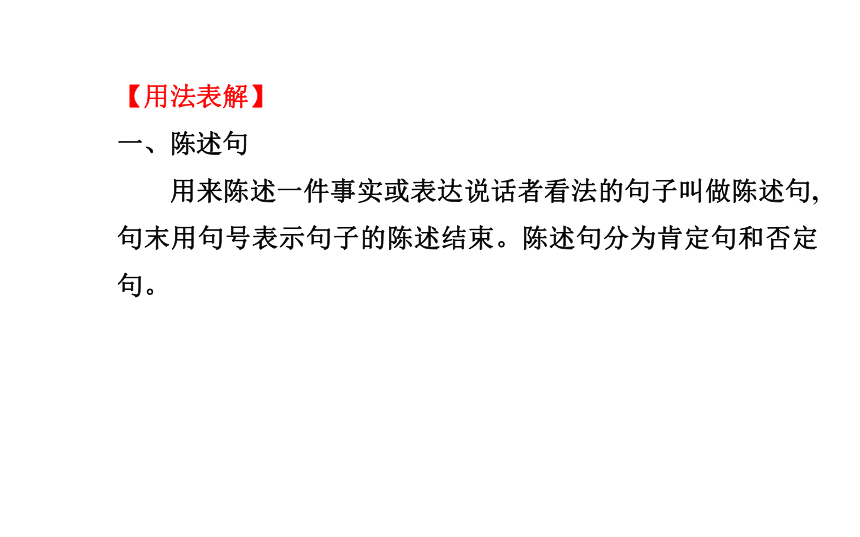

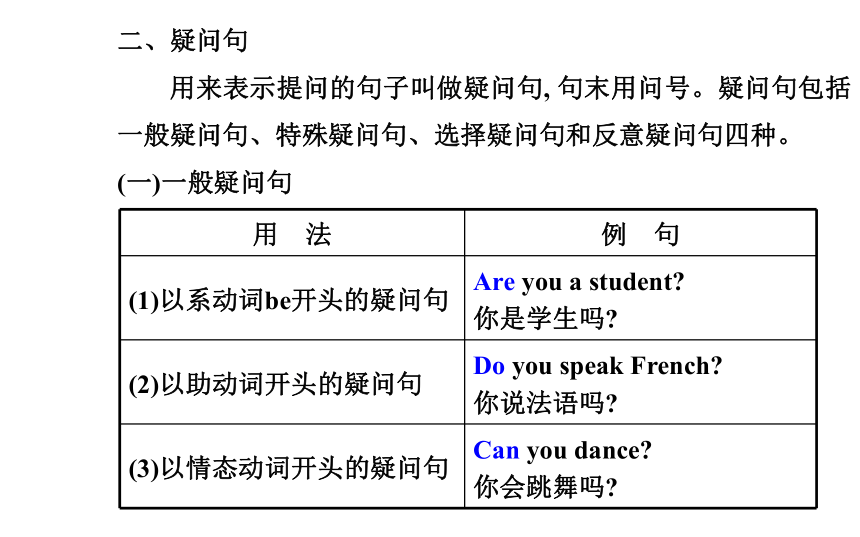
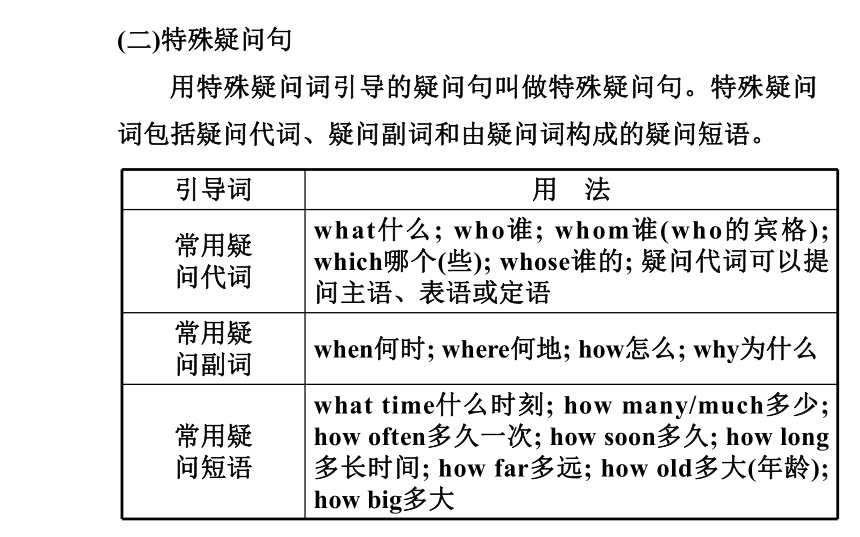
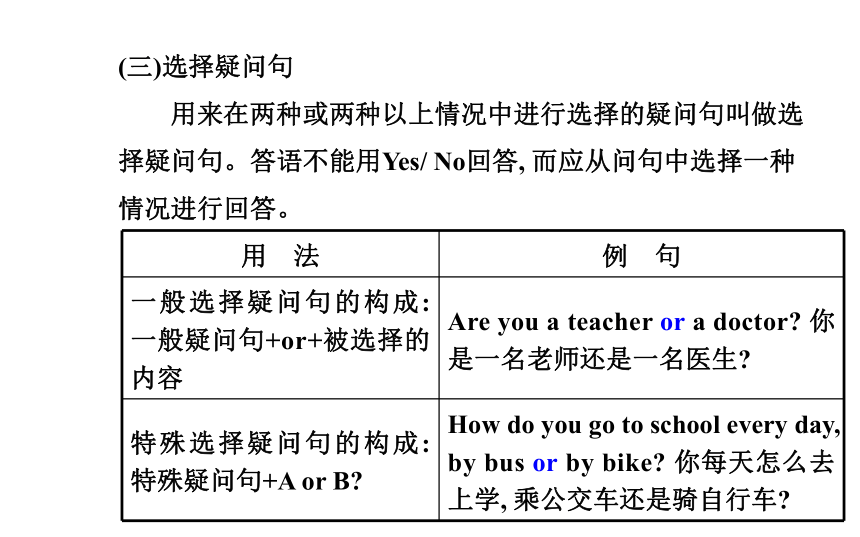
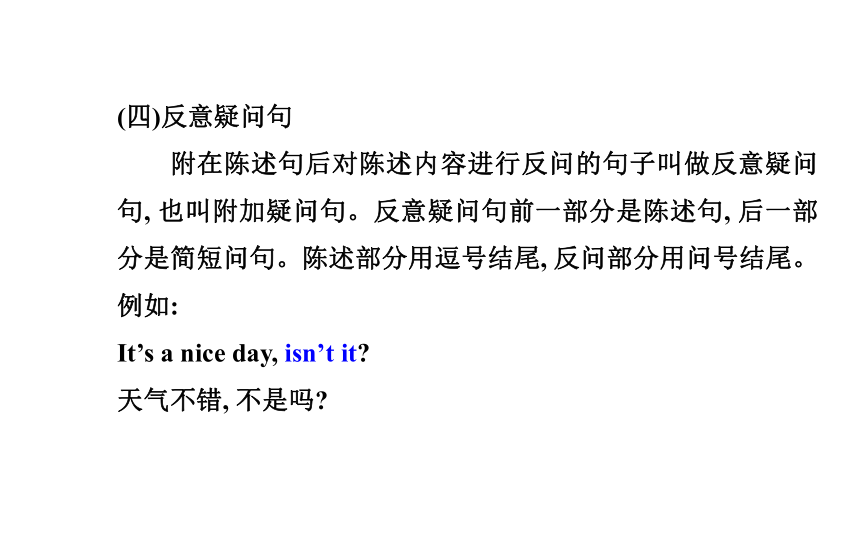
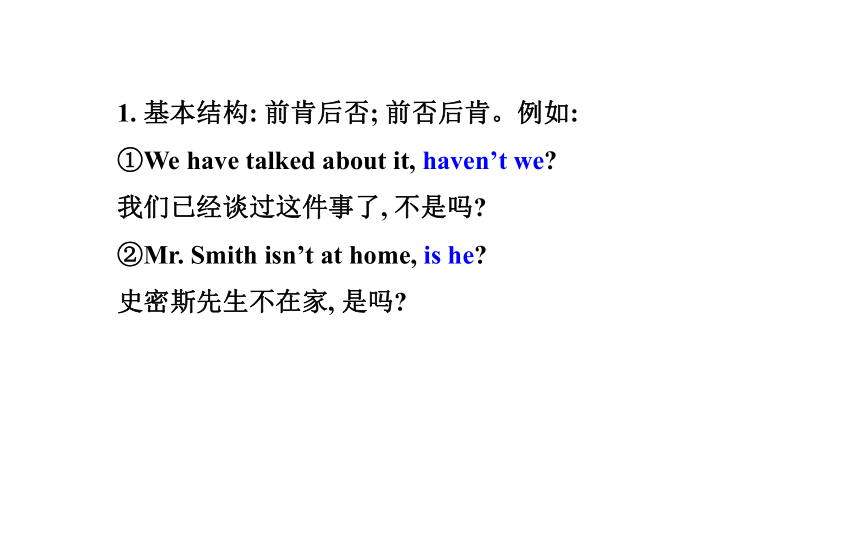
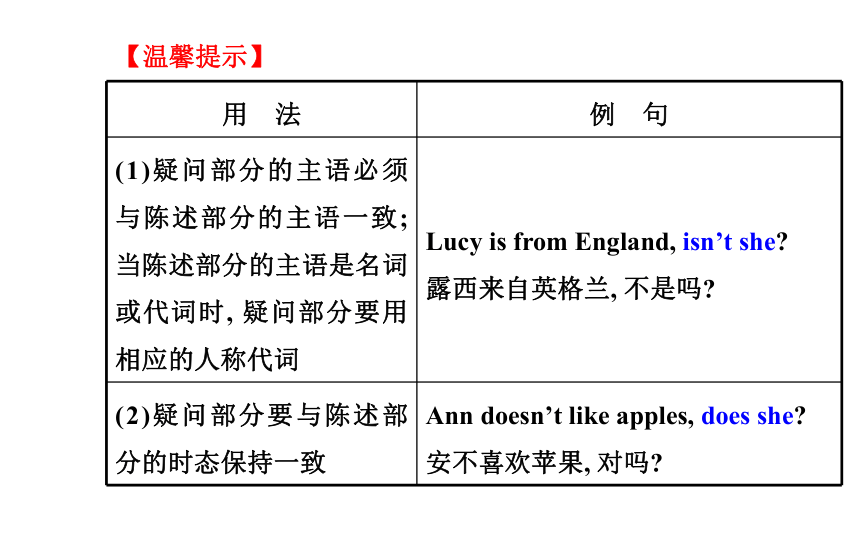
文档简介
课件49张PPT。十三、句子种类考点一 陈述句和疑问句?
【考点探究】
1. My classmates are going to skate in the afternoon.
(改为否定句)
My classmates to skate in the afternoon.
答案: aren’t going 2. Dave sometimes helps in the house at the weekend.
(改为一般疑问句)
Dave sometimes in the house at the weekend?
3. Bruce visits his grandparents once a week.
(对画线部分提问)
does Bruce visit his grandparents?
答案: 2. Does; help 3. How often【用法表解】
一、陈述句
用来陈述一件事实或表达说话者看法的句子叫做陈述句, 句末用句号表示句子的陈述结束。陈述句分为肯定句和否定句。二、疑问句
用来表示提问的句子叫做疑问句, 句末用问号。疑问句包括一般疑问句、特殊疑问句、选择疑问句和反意疑问句四种。
(一)一般疑问句(二)特殊疑问句
用特殊疑问词引导的疑问句叫做特殊疑问句。特殊疑问词包括疑问代词、疑问副词和由疑问词构成的疑问短语。(三)选择疑问句
用来在两种或两种以上情况中进行选择的疑问句叫做选择疑问句。答语不能用Yes/ No回答, 而应从问句中选择一种情况进行回答。(四)反意疑问句
附在陈述句后对陈述内容进行反问的句子叫做反意疑问句, 也叫附加疑问句。反意疑问句前一部分是陈述句, 后一部分是简短问句。陈述部分用逗号结尾, 反问部分用问号结尾。例如:
It’s a nice day, isn’t it?
天气不错, 不是吗? 1. 基本结构: 前肯后否; 前否后肯。例如:
①We have talked about it, haven’t we?
我们已经谈过这件事了, 不是吗?
②Mr. Smith isn’t at home, is he?
史密斯先生不在家, 是吗? 【温馨提示】2. 特殊形式。
(1)当陈述句是I am. . . 时, 反意疑问句用aren’t I。
I’m late for the meeting, aren’t I?
我开会迟到了, 不是吗?
(2)当陈述部分是there be结构时, 反意疑问句用there。
There are some bananas in the basket, aren’t there?
篮子里有些香蕉, 不是吗?
(3)当陈述部分的主语是指示代词this, that时, 反意疑问句的主语用it; 主语是these或those时, 反意疑问句的主语用they。
That isn’t a useful book, is it?
那不是一本有用的书, 是吗? (4)当陈述部分含有never/ nothing/ none/ no one/ seldom/ hardly/ few/ little等否定词时, 反意疑问句用肯定形式。
He hardly remembers his old friend’s name, does he?
他几乎不记得他的老朋友的名字了, 对吗?
(5)如果陈述部分含有由否定前缀 im-, dis-, un-等构成的否定意义的词, 则陈述部分作肯定处理, 反意疑问句仍用否定形式。
It’s impossible for him to make such a mistake, isn’t it?
他不可能犯这样的错误, 不是吗? (6)陈述句主语是不定代词something/ anything/ everything/ nothing等时, 反意疑问句中代词用it。
Everything has gone wrong today, hasn’t it?
今天一切都出问题了, 是不是?
(7)陈述句主语为somebody/ someone/ anybody/ anyone/ everybody/ everyone等时, 反意疑问句中代词用they或he, 注意问句动词的数应与they/ he保持一致。
Nobody came when I was out, did they?
我在外时, 没人来过, 是吗? (8)祈使句的反意疑问句
①祈使句是肯定形式, 其反意疑问句用will you或won’t you皆可。
②祈使句是否定形式, 其反意疑问句通常只用will you。③以Let开头的祈使句构成反意疑问句时, Let’s用shall we构成反意疑问句, 其他均用will you。
Be sure to write to us, will you?
一定要给我们写信, 好吗?
Come to have dinner with us this evening, won’t you?
今晚来跟我们一起吃饭, 好吗?
Don’t smoke in the meeting room, will you?
请不要在会议室抽烟, 好吗?
Let’s take a walk after supper, shall we?
晚饭后, 我们去散步, 好吗? 【温馨提示】
陈述句是I think/I suppose/I believe/I consider等结构时, 问句一般与从句保持一致。注意“否定前移”。
①I think you can do it better next time, can’t you?
我觉得你下次可以做得更好, 是不是?
②I don’t believe there will be robots at people’s homes, will there?
我相信人们的家里不会有机器人的, 会有吗? 考点二 感叹句?
【考点探究】
1. bad weather it is! It’s rainy for two weeks.
A. What B. What a C. How D. How a
2. The beach is a nice place for tourists. (改为感叹句)
nice place the beach is for tourists!
答案: What a【用法表解】
感叹句是用来表达人的特殊感情的句子, 如喜、怒、哀、乐等感情, 带有强烈的感彩。【巧学妙记】
感叹句, 并不难, what或how摆在前。
强调名词用what, 其余用how很简单。
名词若是可数单, 前带冠词a或an。
主语谓语放在后, 省略也是很常见。考点三 祈使句?
【考点探究】
1. smoke here, Dad. Smoking has been banned in public places.
A. Don’t be B. Don’t
C. Not to be D. Be not
2. exercising, and you’ll be healthier.
A. Keep B. To keep
C. Keeping D. Kept3. You must be careful when you cross the street. (改为祈使句)
when you cross the street.
答案: Be careful【用法表解】
祈使句表达说话人对对方的劝告、叮嘱、建议、请求或命令等。主语you通常省略, 谓语动词用原形, 句末用感叹号或句号。表达请求或劝告时, 祈使句句末或句首可以加上please表示委婉的语气。一、肯定祈使句的表现形式二、否定祈使句的表现形式
(1)Do型和Be型的否定式都是在句首加don’t构成。
①Don’t forget me! 不要忘记我!
②Don’t be late for school! 上学不要迟到!
(2)Let型的否定式有两种: “Don’t +let+宾语+动词原形+其他成分”和“Let+宾语+not+动词原形+其他成分”。
Don’t let him go. /Let him not go. 别让他走。
(3)有些可用no开头, 用来表示禁止性的祈使句。
No smoking! 禁止吸烟! 考点四 倒装句?
【考点探究】
1. —I haven’t seen the film Pirates of the Caribbean: On Stranger Tides.
— .
A. Neither have I B. So have I
C. Neither I have D. So I have
2. —Peter doesn’t know any people here.
— .
A. So do I B. So am I
C. Neither am I D. Neither do I【用法表解】
英语句子一般主语在前, 谓语在后。但有时因为语法结构的要求或为了表达特殊的强调部分, 会把句中的谓语提到主语前面。这种句子叫做倒装句。倒装句的常见句式: 【温馨提示】
1. there be与have的区别
(1)there be结构表示“某地有某人/物”, 强调客观存在。
(2)have(has, had)表示“(某人)拥有某物”, 强调所属关系。例如:
Mr. Bush has two daughters. 布什先生有两个女儿。
2. There be句型的句式变化
(1)对There be句型中的主语提问用: What be+地点状语/时间状语? 例如:
There are many birds in the forests. 树林里有许多鸟。
→What’s in the forests? 树林里有什么? (2)对There be句式中数量的提问
①How many +可数名词+ are there +地点状语?
②How much +不可数名词+ is there +地点状语?
(3)There be句型中, 反意疑问句的附加部分应用there。例如:
There’s no air on the moon, is there?
月球上没有空气, 是吗? 3. “So+主语+助动词/系动词/情态动词”表示“确实如此”, 表示对上文所述情况的认可和肯定。例如:
—Nick likes music that he can dance to.
——尼克喜欢能随之跳舞的音乐。
—So he does. ——是啊。(他确实喜欢)考点五 主谓一致?
【考点探究】
1. Thanks to the organization, some money given to the poor children.
A. was B. were C. are D. is
2. —Both Li Lei and Han Meimei fond of the TV program A Bite of China.
—I am also deeply moved by its stories!
A. is B. am C. was D. are【用法表解】
主谓一致是指谓语动词和主语在人称和数上保持一致, 遵循三个原则: ①语法一致②意义一致③就近一致
1. 语法一致
是指主语和谓语动词在语法形式上保持一致, 即主语是单数形式, 谓语动词用单数形式; 主语是复数形式, 谓语动词用复数形式。 例如:
Coffee is more popular in western countries.
咖啡在西方国家更流行。
Some boys are playing in the park.
一些男孩正在公园里玩。
Both Linda and her sister are students.
琳达和她妹妹都是学生。
Jenny with her classmates reads English every morning.
珍妮和她的同学们每天早上都读英语。 The number of doctors in the hospital is about 200 and a number of them are women doctors.
这家医院大约有200名医生, 很多是女医生。
One of my pen pals is from Sydney.
我的笔友中有一位来自悉尼。
None of those books are/is good.
那些书中没有一本是好的。 2. 意义一致
是指谓语动词形式要与主语意义上的单复数形式保持一致 3. 就近一致
是指由部分短语引导主语, 谓语动词根据靠近它的主语名词决定单复数形式。Ⅰ. 单项选择
1. (2013·温州中考)—It’s Father’s Day today, ?
—Yes. Let’s buy a gift for Dad.
A. isn’t it B. doesn’t it C. isn’t he D. doesn’t he
【解析】选A。考查反意疑问句。其前的陈述句中谓语动词用了系动词is, 附加疑问部分也应用is, 且陈述句的主语是it, 故附加疑问句应为“isn’t it”。故选A。2. (2013·济南中考)—Have you heard of Zhang Lili? She was seriously hurt in an accident in order to save one of her students.
— good teacher!
A. How B. What C. What a D. What an
【解析】选C。考查感叹句。teacher是可数名词单数形式, good以辅音音素开头, 所以感叹句用What a. . . ! 。3. (2012·黄石中考) that pair of a little cheaper?
A. Is; glass B. Are; glass
C. Is; glasses D. Are; glasses
【解析】选C。考查主谓一致。that pair of作主语, 谓语动词使用单数形式, 故选C。4. (2012·南通中考)Each of the club members ready to help those who were in trouble.
A. is B. are C. was D. were
【解析】选C。考查主谓一致。“each of+名词”作主语, 谓语动词用单数; 后面句子谓语动词用一般过去时态, 因此前一个句子也要用一般过去时, 故选C。5. (2012·郴州中考)—As a member of bus drivers, I am proud of Wu Bin.
— . He is a hero in my heart.
A. So am I B. So do I C. So I am
【解析】选A。考查倒装结构。so位于句首, 表示“……也这样”时, 主谓通常倒装。Ⅱ. 句型转换
1. (2013·安顺中考)I skated for 6 hours yesterday. (对画线部分提问)
did you skate yesterday?
2. (2013·安顺中考)Our journey to Britain last summer was amazing. (改为感叹句)
our journey to Britain last summer was!
3. (2012·兰州中考)There was some milk in the bottle. (改为否定句)
There milk in the bottle.
答案: 1. How long 2. How amazing 3. wasn’t any
【考点探究】
1. My classmates are going to skate in the afternoon.
(改为否定句)
My classmates to skate in the afternoon.
答案: aren’t going 2. Dave sometimes helps in the house at the weekend.
(改为一般疑问句)
Dave sometimes in the house at the weekend?
3. Bruce visits his grandparents once a week.
(对画线部分提问)
does Bruce visit his grandparents?
答案: 2. Does; help 3. How often【用法表解】
一、陈述句
用来陈述一件事实或表达说话者看法的句子叫做陈述句, 句末用句号表示句子的陈述结束。陈述句分为肯定句和否定句。二、疑问句
用来表示提问的句子叫做疑问句, 句末用问号。疑问句包括一般疑问句、特殊疑问句、选择疑问句和反意疑问句四种。
(一)一般疑问句(二)特殊疑问句
用特殊疑问词引导的疑问句叫做特殊疑问句。特殊疑问词包括疑问代词、疑问副词和由疑问词构成的疑问短语。(三)选择疑问句
用来在两种或两种以上情况中进行选择的疑问句叫做选择疑问句。答语不能用Yes/ No回答, 而应从问句中选择一种情况进行回答。(四)反意疑问句
附在陈述句后对陈述内容进行反问的句子叫做反意疑问句, 也叫附加疑问句。反意疑问句前一部分是陈述句, 后一部分是简短问句。陈述部分用逗号结尾, 反问部分用问号结尾。例如:
It’s a nice day, isn’t it?
天气不错, 不是吗? 1. 基本结构: 前肯后否; 前否后肯。例如:
①We have talked about it, haven’t we?
我们已经谈过这件事了, 不是吗?
②Mr. Smith isn’t at home, is he?
史密斯先生不在家, 是吗? 【温馨提示】2. 特殊形式。
(1)当陈述句是I am. . . 时, 反意疑问句用aren’t I。
I’m late for the meeting, aren’t I?
我开会迟到了, 不是吗?
(2)当陈述部分是there be结构时, 反意疑问句用there。
There are some bananas in the basket, aren’t there?
篮子里有些香蕉, 不是吗?
(3)当陈述部分的主语是指示代词this, that时, 反意疑问句的主语用it; 主语是these或those时, 反意疑问句的主语用they。
That isn’t a useful book, is it?
那不是一本有用的书, 是吗? (4)当陈述部分含有never/ nothing/ none/ no one/ seldom/ hardly/ few/ little等否定词时, 反意疑问句用肯定形式。
He hardly remembers his old friend’s name, does he?
他几乎不记得他的老朋友的名字了, 对吗?
(5)如果陈述部分含有由否定前缀 im-, dis-, un-等构成的否定意义的词, 则陈述部分作肯定处理, 反意疑问句仍用否定形式。
It’s impossible for him to make such a mistake, isn’t it?
他不可能犯这样的错误, 不是吗? (6)陈述句主语是不定代词something/ anything/ everything/ nothing等时, 反意疑问句中代词用it。
Everything has gone wrong today, hasn’t it?
今天一切都出问题了, 是不是?
(7)陈述句主语为somebody/ someone/ anybody/ anyone/ everybody/ everyone等时, 反意疑问句中代词用they或he, 注意问句动词的数应与they/ he保持一致。
Nobody came when I was out, did they?
我在外时, 没人来过, 是吗? (8)祈使句的反意疑问句
①祈使句是肯定形式, 其反意疑问句用will you或won’t you皆可。
②祈使句是否定形式, 其反意疑问句通常只用will you。③以Let开头的祈使句构成反意疑问句时, Let’s用shall we构成反意疑问句, 其他均用will you。
Be sure to write to us, will you?
一定要给我们写信, 好吗?
Come to have dinner with us this evening, won’t you?
今晚来跟我们一起吃饭, 好吗?
Don’t smoke in the meeting room, will you?
请不要在会议室抽烟, 好吗?
Let’s take a walk after supper, shall we?
晚饭后, 我们去散步, 好吗? 【温馨提示】
陈述句是I think/I suppose/I believe/I consider等结构时, 问句一般与从句保持一致。注意“否定前移”。
①I think you can do it better next time, can’t you?
我觉得你下次可以做得更好, 是不是?
②I don’t believe there will be robots at people’s homes, will there?
我相信人们的家里不会有机器人的, 会有吗? 考点二 感叹句?
【考点探究】
1. bad weather it is! It’s rainy for two weeks.
A. What B. What a C. How D. How a
2. The beach is a nice place for tourists. (改为感叹句)
nice place the beach is for tourists!
答案: What a【用法表解】
感叹句是用来表达人的特殊感情的句子, 如喜、怒、哀、乐等感情, 带有强烈的感彩。【巧学妙记】
感叹句, 并不难, what或how摆在前。
强调名词用what, 其余用how很简单。
名词若是可数单, 前带冠词a或an。
主语谓语放在后, 省略也是很常见。考点三 祈使句?
【考点探究】
1. smoke here, Dad. Smoking has been banned in public places.
A. Don’t be B. Don’t
C. Not to be D. Be not
2. exercising, and you’ll be healthier.
A. Keep B. To keep
C. Keeping D. Kept3. You must be careful when you cross the street. (改为祈使句)
when you cross the street.
答案: Be careful【用法表解】
祈使句表达说话人对对方的劝告、叮嘱、建议、请求或命令等。主语you通常省略, 谓语动词用原形, 句末用感叹号或句号。表达请求或劝告时, 祈使句句末或句首可以加上please表示委婉的语气。一、肯定祈使句的表现形式二、否定祈使句的表现形式
(1)Do型和Be型的否定式都是在句首加don’t构成。
①Don’t forget me! 不要忘记我!
②Don’t be late for school! 上学不要迟到!
(2)Let型的否定式有两种: “Don’t +let+宾语+动词原形+其他成分”和“Let+宾语+not+动词原形+其他成分”。
Don’t let him go. /Let him not go. 别让他走。
(3)有些可用no开头, 用来表示禁止性的祈使句。
No smoking! 禁止吸烟! 考点四 倒装句?
【考点探究】
1. —I haven’t seen the film Pirates of the Caribbean: On Stranger Tides.
— .
A. Neither have I B. So have I
C. Neither I have D. So I have
2. —Peter doesn’t know any people here.
— .
A. So do I B. So am I
C. Neither am I D. Neither do I【用法表解】
英语句子一般主语在前, 谓语在后。但有时因为语法结构的要求或为了表达特殊的强调部分, 会把句中的谓语提到主语前面。这种句子叫做倒装句。倒装句的常见句式: 【温馨提示】
1. there be与have的区别
(1)there be结构表示“某地有某人/物”, 强调客观存在。
(2)have(has, had)表示“(某人)拥有某物”, 强调所属关系。例如:
Mr. Bush has two daughters. 布什先生有两个女儿。
2. There be句型的句式变化
(1)对There be句型中的主语提问用: What be+地点状语/时间状语? 例如:
There are many birds in the forests. 树林里有许多鸟。
→What’s in the forests? 树林里有什么? (2)对There be句式中数量的提问
①How many +可数名词+ are there +地点状语?
②How much +不可数名词+ is there +地点状语?
(3)There be句型中, 反意疑问句的附加部分应用there。例如:
There’s no air on the moon, is there?
月球上没有空气, 是吗? 3. “So+主语+助动词/系动词/情态动词”表示“确实如此”, 表示对上文所述情况的认可和肯定。例如:
—Nick likes music that he can dance to.
——尼克喜欢能随之跳舞的音乐。
—So he does. ——是啊。(他确实喜欢)考点五 主谓一致?
【考点探究】
1. Thanks to the organization, some money given to the poor children.
A. was B. were C. are D. is
2. —Both Li Lei and Han Meimei fond of the TV program A Bite of China.
—I am also deeply moved by its stories!
A. is B. am C. was D. are【用法表解】
主谓一致是指谓语动词和主语在人称和数上保持一致, 遵循三个原则: ①语法一致②意义一致③就近一致
1. 语法一致
是指主语和谓语动词在语法形式上保持一致, 即主语是单数形式, 谓语动词用单数形式; 主语是复数形式, 谓语动词用复数形式。 例如:
Coffee is more popular in western countries.
咖啡在西方国家更流行。
Some boys are playing in the park.
一些男孩正在公园里玩。
Both Linda and her sister are students.
琳达和她妹妹都是学生。
Jenny with her classmates reads English every morning.
珍妮和她的同学们每天早上都读英语。 The number of doctors in the hospital is about 200 and a number of them are women doctors.
这家医院大约有200名医生, 很多是女医生。
One of my pen pals is from Sydney.
我的笔友中有一位来自悉尼。
None of those books are/is good.
那些书中没有一本是好的。 2. 意义一致
是指谓语动词形式要与主语意义上的单复数形式保持一致 3. 就近一致
是指由部分短语引导主语, 谓语动词根据靠近它的主语名词决定单复数形式。Ⅰ. 单项选择
1. (2013·温州中考)—It’s Father’s Day today, ?
—Yes. Let’s buy a gift for Dad.
A. isn’t it B. doesn’t it C. isn’t he D. doesn’t he
【解析】选A。考查反意疑问句。其前的陈述句中谓语动词用了系动词is, 附加疑问部分也应用is, 且陈述句的主语是it, 故附加疑问句应为“isn’t it”。故选A。2. (2013·济南中考)—Have you heard of Zhang Lili? She was seriously hurt in an accident in order to save one of her students.
— good teacher!
A. How B. What C. What a D. What an
【解析】选C。考查感叹句。teacher是可数名词单数形式, good以辅音音素开头, 所以感叹句用What a. . . ! 。3. (2012·黄石中考) that pair of a little cheaper?
A. Is; glass B. Are; glass
C. Is; glasses D. Are; glasses
【解析】选C。考查主谓一致。that pair of作主语, 谓语动词使用单数形式, 故选C。4. (2012·南通中考)Each of the club members ready to help those who were in trouble.
A. is B. are C. was D. were
【解析】选C。考查主谓一致。“each of+名词”作主语, 谓语动词用单数; 后面句子谓语动词用一般过去时态, 因此前一个句子也要用一般过去时, 故选C。5. (2012·郴州中考)—As a member of bus drivers, I am proud of Wu Bin.
— . He is a hero in my heart.
A. So am I B. So do I C. So I am
【解析】选A。考查倒装结构。so位于句首, 表示“……也这样”时, 主谓通常倒装。Ⅱ. 句型转换
1. (2013·安顺中考)I skated for 6 hours yesterday. (对画线部分提问)
did you skate yesterday?
2. (2013·安顺中考)Our journey to Britain last summer was amazing. (改为感叹句)
our journey to Britain last summer was!
3. (2012·兰州中考)There was some milk in the bottle. (改为否定句)
There milk in the bottle.
答案: 1. How long 2. How amazing 3. wasn’t any
同课章节目录
- 词法
- 名词
- 动词和动词短语
- 动词语态
- 动词时态
- 助动词和情态动词
- 非谓语动词
- 冠词
- 代词
- 数词和量词
- 形容词副词及其比较等级
- 介词和介词短语
- 连词和感叹词
- 构词法
- 相似、相近词比较
- 句法
- 陈述句
- 一般疑问句和否定疑问句
- 特殊疑问句及选择疑问句
- 反意疑问句
- 存在句(There be句型)
- 宾语从句
- 定语从句
- 状语从句
- 主谓一致问题
- 简单句
- 并列句
- 复合句
- 主谓一致
- 主、表语从句
- 名词性从句
- 直接引语和间接引语
- 虚拟语气
- 感叹句
- 强调句
- 倒装句
- 祈使句
- 句子的成分
- 句子的分类
- 题型专区
- 单项选择部分
- 易错题
- 完形填空
- 阅读理解
- 词汇练习
- 听说训练
- 句型转换
- 补全对话
- 短文改错
- 翻译
- 书面表达
- 任务型阅读
- 语法填空
- 其他资料
